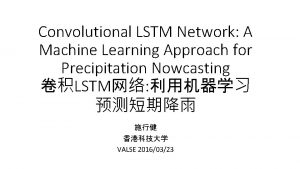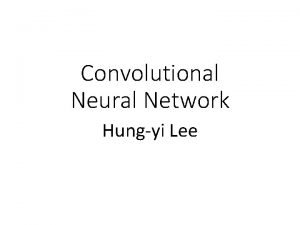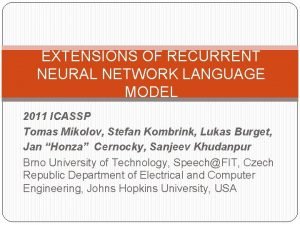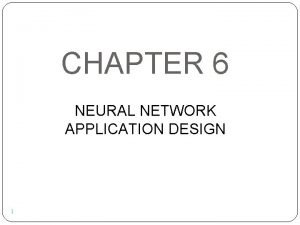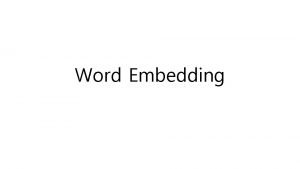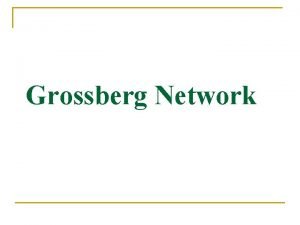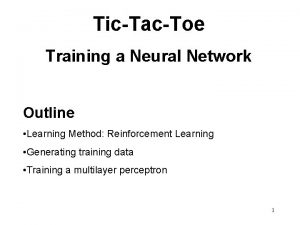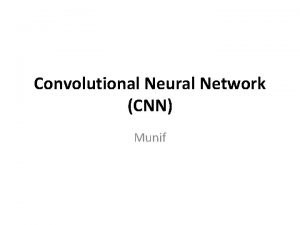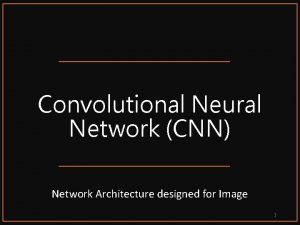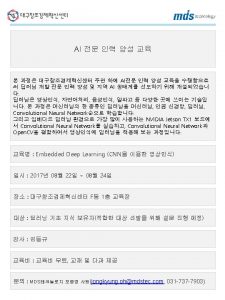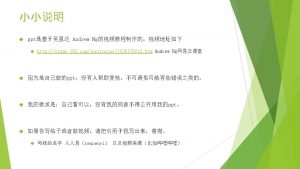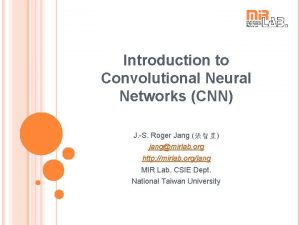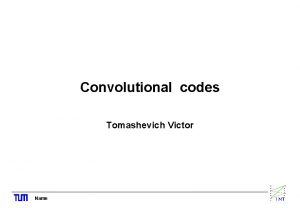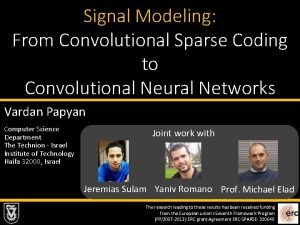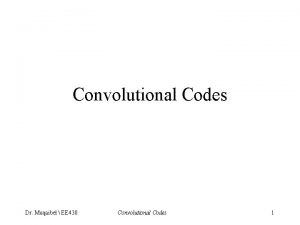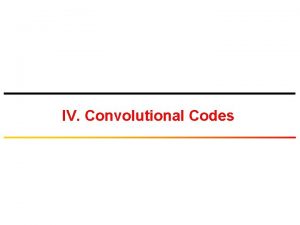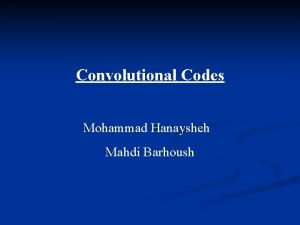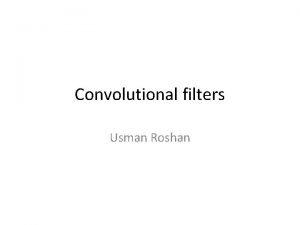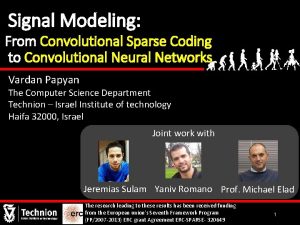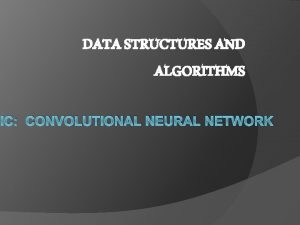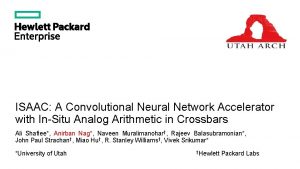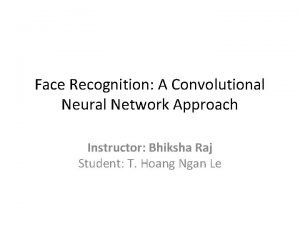Convolutional Neural Network CNN Munif CNN The CNN






















- Slides: 22

Convolutional Neural Network (CNN) Munif

CNN • The (CNN) consists of: – Convolutional layers – Subsampling Layers – Fully connected layers • Has achieved state-of-the-art result for the recognition of handwritten digits

Neural Network And CNN • CNN has fewer connections – Replicating Weights • Easier to train – reduce the training time. • A large-scale datasets • input are images ( 2 D ) • CNN tricky to train

Convolution - The new size after convolution! • Adapted from: http: //deeplearning. stanford. edu/wiki/index. php/File: Convolution_schematic. gif

Pooling ( down sampling ) 2 2 4 4 2 4 8 4 4 1 6 10 3 4 Max pooling 4 8 10 4 - The new size after pooling! Mean Pooling 2. 5 5 6 3

Convolutional Layer • Has feature maps: – has small filters ( weights ) – the most common size: – (5 * 5) or (3 * 3 ) – Has Bias • Its size = input size – filter + 1 = the size of output of layer - Each feature map has 1 or more inputs

Pooling Layer • Has feature maps: – perform down-sampling on the input. – Each feature map has 1 weight kernel and 1 bias – The most common size: 2× 2 – larger size may remove and throw away too much information – Has Bias • Its size = input size/2 = size of the output of this layer - Each feature map has 1 input • Reduces computation

The architecture of the CNN • Vary, mainly depends on the data ( size, type. . etc) • (Le. Net Models ) – proposed by Yann Le. Cun • Other: – Multiresolution CNN architecture • 1 million You. Tube videos annotated with 487 classes • http: //cs. stanford. edu/people/karpathy/deepvideo/de epvideo_cvpr 2014. pdf


The Connections Between Layers • These connections are also referred as receptive fields (RF) – Custom table connections – Random connections – Fully connected layers

forward propagation _ If Convolutional Layer • Convolve the inputs with the corresponding kernel. • Add Bias to the results _ If pooling Layer • Down-sampling the inputs. • Add Bias to the results _ Apply activation function ( Ex. sigmoid, hyperbolic tangent) Q = F(A) Fully Connected H 4 _ Fully Connected (NN ) H 3 H 1 Input H 2 H 1 = Convolutional H 2 = pooling H 3 = Convolutional H 4 = Pooling

Backpropagation • • Is almost identical to the Backpropagation algorithm for standard NN. Calculating the delta Error ( D) Updating weight and bias (W) differences – weight sharing – sub-sampling layers H 3 H 4 Vector Fully Connected H 2 Input H 1 = Convolutional H 2 = pooling H 3 = Convolutional H 4 = Pooling

Backpropagation in Convolutional layer: Up-sampling § To calculate the delta error of Convolutional layer: § do up-sample: To propagate the error from the Subsampling (pooling) layer. § Then multiply the result of the Up-sample by the derivative of the activation function. § Example: In case of mean pooling: Kron = Kroneckor Tensor Product of two matrices

Backpropagation in Subsampling layer: • 1 1 1 1 0 1 1 1 1 2 6 6 4 2 6 6 1 0 1 2 3

Updating Weight Output of last map Q ( l-1) • In Convolutional Layer. 10 10 10 1 1 1 Delta (d) * learning rate 1 2 3 4 • In Pooling layer, it does not make a big difference.

Convolutional NN Libraries. • Theano: http: //deeplearning. net/ • Facebook AI Research (FAIR): open sources deep-learning modules for Torch • Caffe, by student from UC Berkeley • Deep Learning Toolbox: By Rasmus • • http: //www. mathworks. com/matlabcentral/fileexchange/38310 -deep-learningtoolbox

The MNIST database of handwritten digits • Has – Training set of 60, 000 examples – Test set of 10, 000 examples – The size of each Image 28 x 28 – Can be download from http: //yann. lecun. com/exdb/mnist/

Reshape and Prepare Datasets • • train_x = double(reshape(train_x', 28, 60000))/255; test_x = double(reshape(test_x', 28, 10000))/255; train_y = double(train_y'); test_y = double(test_y');

Define layers of CNN • Creating 5 Layers including the input layer. • • cnn. layers = { struct('type', 'i') %input layer struct('type', 'c', 'outputmaps', 6, 'kernelsize', 5) %convolution layer struct('type', 'scale', 2) %sub sampling layer struct('type', 'c', 'outputmaps', 12, 'kernelsize', 5) %convolution layer struct('type', 'scale', 2) %subsampling layer };

Define the Parameters • opts. alpha = 0. 1; • opts. batchsize = 2; • opts. numepochs = 50;

Training and Testing • Setting up the network: – cnn = cnnsetup(cnn, train_x, train_y); • Train_CNN – cnn = cnntrain(cnn, train_x, train_y, opts); • Test_CNN – cnntest(cnn, test_x, test_y);

Thank You
 Convolutional neural network alternatives
Convolutional neural network alternatives Convolutional neural network
Convolutional neural network Cnn ppt
Cnn ppt Convolutional neural networks for visual recognition
Convolutional neural networks for visual recognition Lmu cis
Lmu cis Leon gatys
Leon gatys Convolutional neural networks
Convolutional neural networks Sparse convolutional neural networks
Sparse convolutional neural networks Visualizing and understanding convolutional networks
Visualizing and understanding convolutional networks Xooutput
Xooutput Conv lstm
Conv lstm Move19x
Move19x Extensions of recurrent neural network language model
Extensions of recurrent neural network language model Tlu in neural network
Tlu in neural network Rnn andrew ng
Rnn andrew ng Network application design
Network application design Nnlm neural network
Nnlm neural network Grossberg network
Grossberg network Decision boundary of neural network
Decision boundary of neural network Least mean square algorithm in neural network
Least mean square algorithm in neural network Matlab neural network toolbox pdf
Matlab neural network toolbox pdf Neural tensor network
Neural tensor network Neural network tic tac toe
Neural network tic tac toe










